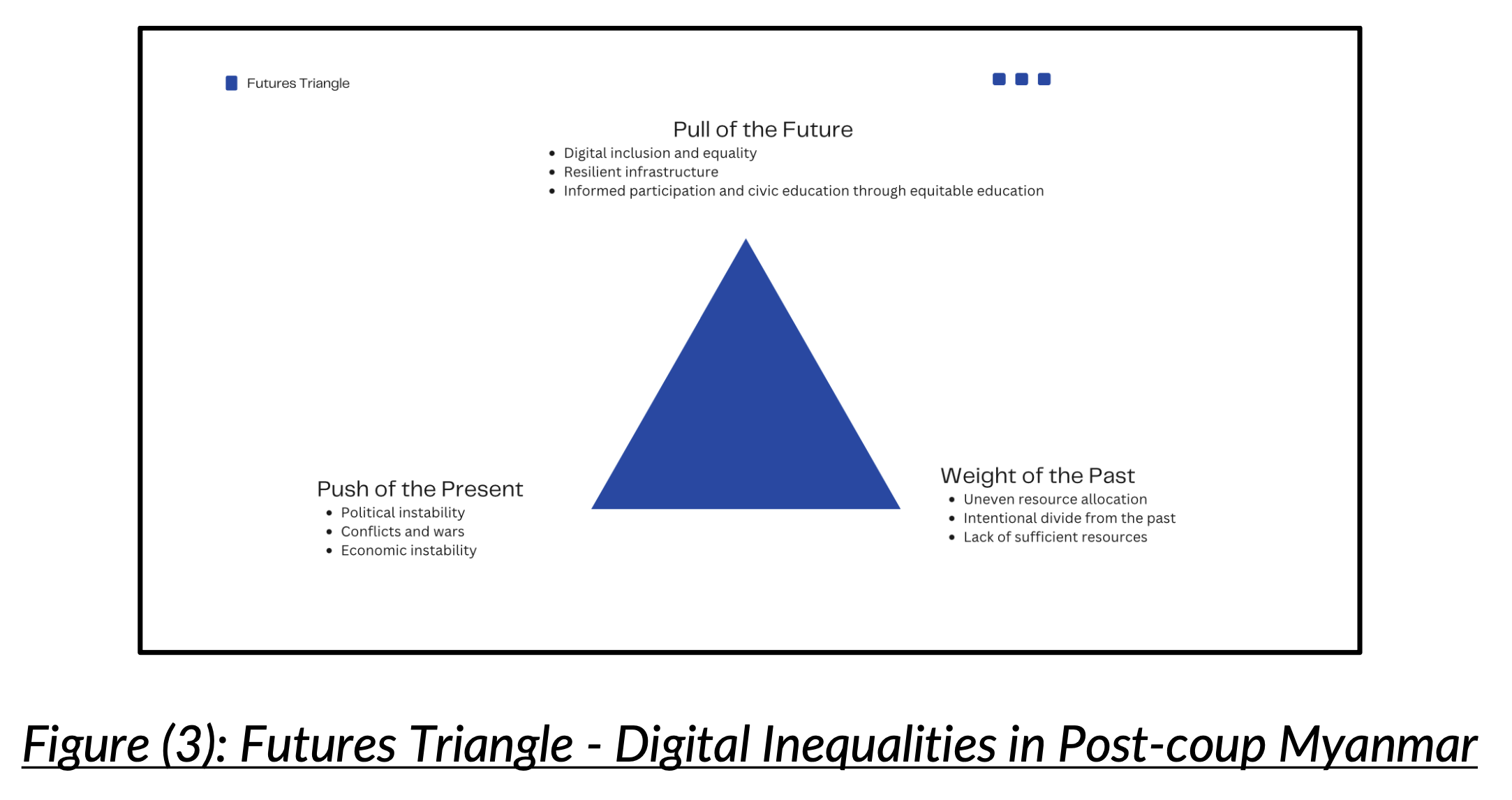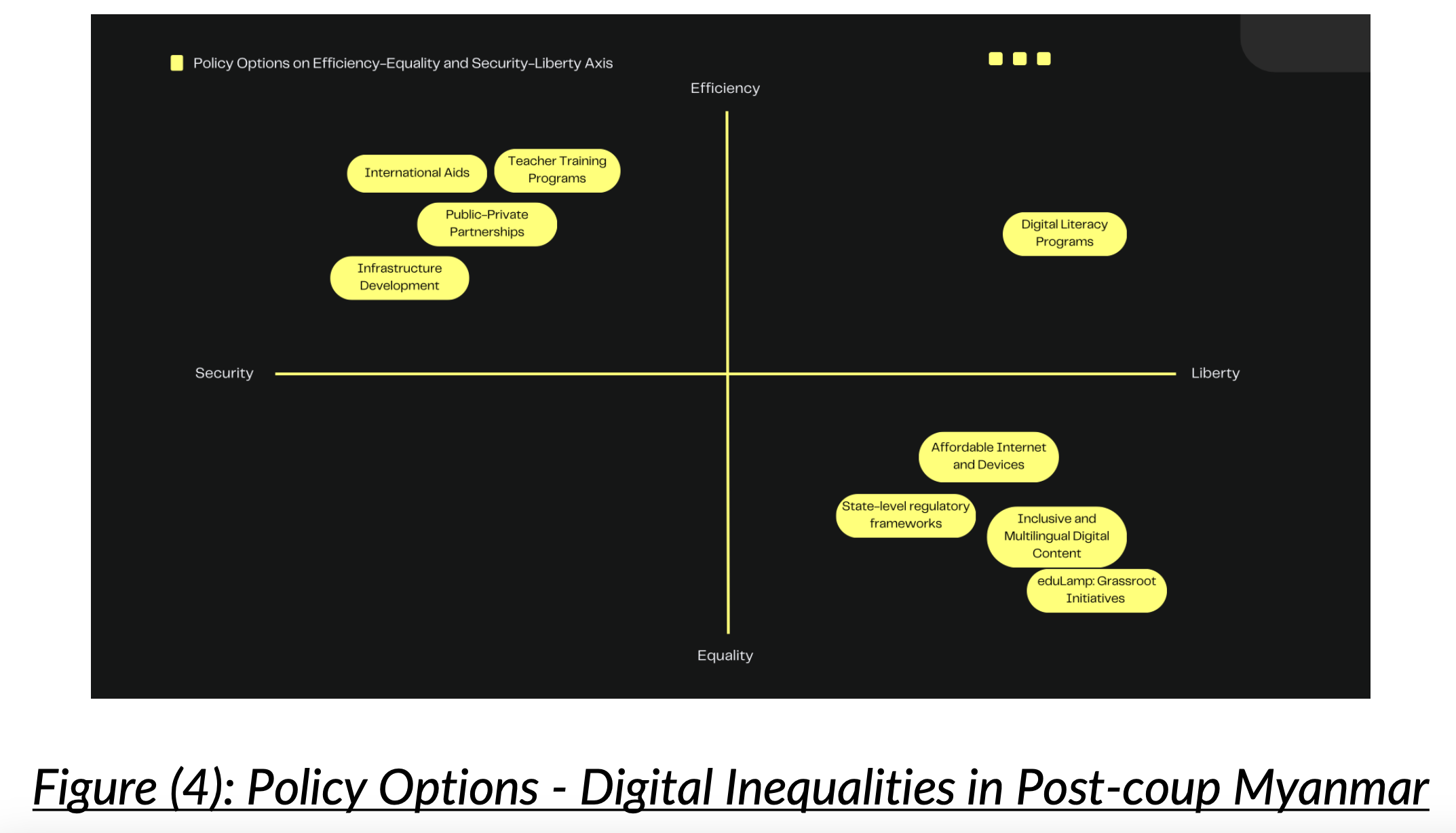DIGITAL INEQUALITY IN CRISIS: ANALYZING THE EDULAMP PROJECT AS A GRASSROOTS RESPONSE TO CONNECTIVITY GAPS IN MYANMAR

Author: Htut Wai Yan
Advisor: Piyapong Boossabong
PROBLEM STATEMENT
Myanmar’s 2021 military coup triggered a national crisis that has devastated the country’s education system. Internet shutdowns, armed conflict, infrastructure sabotage, and the displacement of millions have pushed the country into a state where digital access is no longer a developmental challenge but a barrier to basic human rights. In regions such as Sagaing, Magway, Chin, and Karenni, entire communities have been cut off from online learning for months at a time. With more than 300 telecommunications towers destroyed and over 275 internet shutdowns recorded since the coup, learning continuity has become nearly impossible for students in rural, ethnic, and conflict-affected communities (Myanmar Internet Project, 2024; Johnston, Costa, & Marn, 2024).
Even before the coup, digital inclusion was uneven. Rural infrastructure gaps, low digital literacy, and systemic neglect of ethnic areas made access to online learning fragile. The COVID-19 pandemic exposed this inequality. But after the coup, that fragility collapsed entirely. The assumption that internet-based learning could provide an alternative during crises no longer holds in Myanmar, where electricity cuts, surveillance, and repression have become daily realities. For many, learning has not just moved online, it has disappeared.
Traditional education interventions by civil society and international organizations, such as online learning platforms, digital literacy programs, or classroom-based teacher training, often require a level of connectivity and stability that no longer exists. These models, while effective in more stable environments, have failed to meet the urgent needs of learners living under curfews, military occupation, or in displacement camps with no reliable internet or power.
This is not only a technological problem but a crisis of equity, resilience, and human rights. Without interventions that function independently of digital infrastructure, Myanmar risks losing an entire generation of learners in the most vulnerable regions. There is an urgent need for alternative delivery models that can operate in fragile environments and reach disconnected populations.
One such response is the eduLamp initiative which is a grassroots, offline digital learning system that allows students to access pre-loaded content through portable local Wi-Fi hubs without needing internet or stable electricity. Developed by Spring University Myanmar and young people, eduLamp offers a practical, low-tech solution to bridge the digital divide. It is adaptable, community-driven, and operational in the most difficult settings where conventional systems fail.
This policy brief analyzes the eduLamp project as a case study to understand whether grassroots innovation can address educational exclusion in crisis-affected contexts. It also explores what policy lessons can be drawn to support inclusive, scalable, and resilient education models, both for Myanmar and other fragile states globally.
POLICY ANALYSIS
This study applied a multi-layered policy analysis to examine the eduLamp project, a grassroots offline education initiative developed in response to Myanmar’s post-coup digital divide. The analysis combined conceptual frameworks with stakeholder interviews and thematic coding to assess how eduLamp functions and what it reveals about education policy in fragile contexts.
Understanding the Systemic Crisis
Causal Layered Analysis (CLA) and Causal Loop Mapping (CLM) helped unpack the visible and hidden drivers of digital inequality. While the surface-level problem is a lack of internet, devices, and electricity, deeper causes include decades of rural underinvestment, the marginalization of ethnic education systems, and the militarization of digital infrastructure. CLM revealed reinforcing loops between conflict, displacement, infrastructure damage, and exclusion from education. In this environment, traditional digital education models designed for stable systems are structurally unviable.

Futures Thinking and Strategic Gaps
The Futures Triangle highlighted the tension between long-standing barriers (“the weight of the past”), current crisis pressures (“the push of the present”), and hopes for an inclusive digital education system (“the pull of the future”). Although stakeholders envision digitally inclusive education, current conflicts, infrastructure, and political will are insufficient. This gap calls for policy options that are both immediately deployable and aligned with future educational equity goals.

Why Grassroots Innovation Was Prioritized
The Policy Options Matrix categorized potential interventions along the axes of Efficiency-Equality and Security-Liberty. While centralized infrastructure investments and formal education recovery programs sit in the Efficiency-Security quadrant, they are not feasible in many parts of Myanmar. eduLamp, by contrast, falls within the Equality-Liberty quadrant, offering an inclusive, adaptable model developed by local actors for underserved communities. Although not a replacement for national solutions, grassroots models can function in high-risk, low-access settings as an interim but essential stopgap.

Key Findings
eduLamp uses low-cost devices (Raspberry Pi-based Wi-Fi hotspots) to deliver preloaded educational content to students in remote areas without internet. Interviews with the implementation team, local teachers, community partners, and a donor revealed key insights:
- Access and Usability: The model works, but its reach is limited. Each box supports only 20 simultaneous students at a time, and many learners lack personal devices.
- Teacher Adaptation: Local teachers have creatively adapted eduLamp, using one device and blackboards to teach multiple students at once. However, technical training and hardware support remain limited.
- Community Trust: The initiative is grounded in community collaboration and trusted relationships, which has facilitated its acceptance and survival under dangerous conditions.
- Operational Constraints: Challenges include limited funds, hardware damage during transport, bandwidth limitations, and the difficulty of providing remote support to some areas.
Despite these constraints, feedback from students, teachers, and community leaders affirms eduLamp’s relevance, usability, and potential for scale. It operates in areas where other interventions cannot and supports learners who would otherwise be left behind.
Stakeholder Dynamics
Stakeholder analysis showed that while donors contribute funding, their interest is often limited to outcomes and reporting. Local authorities can be enablers or gatekeepers depending on political sensitivities. Teachers and community leaders hold high interest but low influence, and the youth-led eduLamp team carries operational responsibility with limited financial support. These dynamics suggest that future policy must not only fund grassroots efforts but also empower local actors through training, trust, and mobility.
eduLamp offers a powerful proof of concept: grassroots innovations can sustain learning during systemic breakdowns. However, they cannot operate at scale without targeted policy and support. This analysis reinforces the need to treat community-based models not as peripheral but as core components of crisis-responsive education systems in Myanmar and beyond.
Policy Recommendations
Based on the analysis of the eduLamp project and broader systemic challenges in Myanmar’s post-coup education landscape, this brief proposes the following policy recommendations:
Strengthen Support for Community-Led and Grassroots Education Models
Given the failure of conventional state or donor-led systems to meet the needs of marginalized learners during the current crisis, it is essential to support community-led models that are already demonstrating local impact. Initiatives like eduLamp, which operate with limited resources and community trust, fill critical gaps in education access. Local authorities and international actors should recognize these models as legitimate interim solutions and provide them with the policy space, protection, and institutional recognition needed to operate more effectively.
Provide Technical and Financial Support to Expand Grassroot Innovations
To sustain and scale eduLamp’s impact, targeted investments are needed in both technical and financial areas. These include funding for device procurement, bandwidth expansion, content development, and logistics, as well as technical assistance for improving hardware durability and training local facilitators. As the current model can support only 20 simultaneous users per box, expanding technical capacity is key to reaching more learners. Donors, development agencies, and education funds should consider earmarking flexible grants or innovation funds for the grassroot initiatives.
Recognize the Role of Grassroots Models as Interim Solutions in Fragile Contexts
While national-level digital infrastructure and public education systems offer long-term solutions, they are often inaccessible or ineffective in fragile and repressive settings. In such contexts, grassroots education models serve as practical, scalable stopgaps. Policymakers and development partners should avoid waiting for centralized systems to recover, and instead enable and scale local solutions that are already working. As stability returns, these models may be gradually integrated into national systems to enhance sustainability and coordination.
Equip Local Teachers and Communities with Tools, Content, and Training
For grassroots models to succeed, the communities implementing them must be well-resourced and empowered. Local teachers and facilitators require not only access to devices but also training in digital facilitation, offline content usage, and basic hardware maintenance. Community partners emphasized the need for context-relevant materials and practical tools. Capacity-building efforts should focus on strengthening the role of these frontline actors as the backbone of alternative education delivery in fragile contexts.
Broader Applicability: A Blueprint for Crisis-Responsive Education
While this study focuses on Myanmar, the insights and recommendations are applicable to other fragile, low-connectivity, or conflict-affected settings. The eduLamp model has potential as a blueprint for localized, crisis-resilient education systems. The eduLamp team itself has expressed openness to wider partnerships, sharing, and adaptation of their approach. International organizations and humanitarian networks should consider adopting and localizing such models to ensure learning continuity wherever traditional education systems break down.
Conclusion
Myanmar’s post-coup digital divide is not merely a technological challenge, but it is a crisis of educational equity, access, and human rights. Traditional models of education delivery have limited capacity in conflict-affected and digitally disconnected areas, leaving millions of students without meaningful opportunities to learn. In this vacuum, grassroots innovations have emerged as practical, community-driven responses that can operate without reliance on fragile infrastructure, and eduLamp is one of them.
This policy brief has examined eduLamp as a case study of how local actors are creatively bridging the education gap in the absence of formal systems. The findings highlight not only the feasibility of offline learning models, but also their scalability, adaptability, and potential relevance for other fragile states.
As Myanmar’s crisis continues and similar challenges arise elsewhere, it is essential for policy actors, donors, and education networks to move beyond centralized solutions and invest in grassroots resilience. Supporting models like eduLamp is not simply a matter of innovation, it is a necessary step toward ensuring that no learner is left behind in times of disruption.
References
[1] Braun, V., & Clarke, V. (2006). Using thematic analysis in psychology. Qualitative Research in Psychology, 3(2), 77–101.
https://www.tandfonline.com/doi/abs/10.1191/1478088706qp063oa
[2] Bryson, J. M. (2004). What to do when stakeholders matter: A guide to stakeholder identification and analysis techniques. Public Management Review, 6(1), 21–53.
https://www.tandfonline.com/doi/abs/10.1080/14719030410001675722
[3] Dolowitz, D. P., & Marsh, D. (2000). Learning from abroad: The role of policy transfer in contemporary policy-making. Governance, 13(1), 5–24.
https://onlinelibrary.wiley.com/doi/10.1111/0952-1895.00121
[4] Euronews. (2021, March 17). Myanmar’s internet shutdowns: What’s happening and why it matters. Euronews.
https://www.euronews.com/next/2021/03/17/myanmar-s-internet-shutdowns-what-s-happening-and-why-it-matters
[5] Inayatullah, S. (2008). Six pillars: Futures thinking for transforming. Foresight, 10(1), 4–21.
https://www.emerald.com/insight/content/doi/10.1108/14636680810855991/full/html
[6] Inter-agency Network for Education in Emergencies (INEE). (2010). Minimum standards for education: Preparedness, response, recovery. INEE.
https://inee.org/resources/inee-minimum-standards
[7] Johnston, J., Costa, E., & Marn, S. (2024). Mapping Myanmar’s Higher Education in Crisis: Community and Ethnic Providers after the Coup. BHESS Network.
[8] Kim, D. H. (1992). Systems archetypes I: Diagnosing systemic issues and designing high-leverage interventions.Pegasus Communications.
[9] Myanmar Internet Project. (2024). Myanmar Internet Blackout Report 2021–2024. Myanmar Internet Project.
[10] Reuters. (2021, September 6). Myanmar telecom towers destroyed as clashes escalate. Reuters.
https://www.reuters.com/world/asia-pacific/myanmar-telecom-towers-destroyed-clashes-escalate-2021-09-06/
[11] Van Dijk, J. (2006). Digital divide research, achievements and shortcomings. Poetics, 34(4–5), 221–235.
https://www.sciencedirect.com/science/article/pii/S0304422X06000167?via%3Dihub
[12] Yin, R. K. (2018). Case study research and applications: Design and methods (6th ed.). Sage Publications.
Download full article: Click
